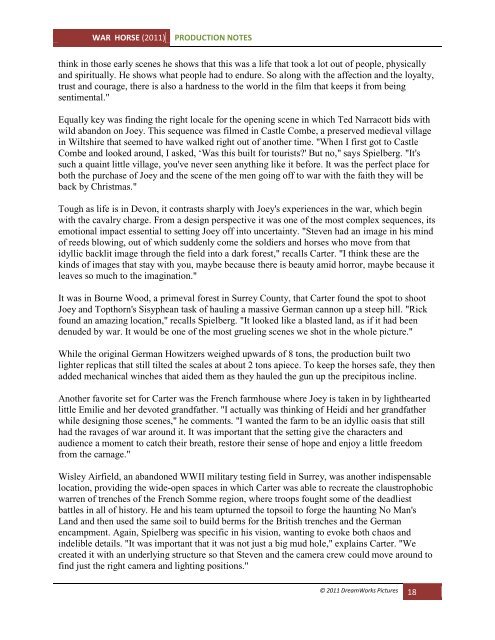WAR HORSE Production Notes
WAR HORSE Production Notes
WAR HORSE Production Notes
Create successful ePaper yourself
Turn your PDF publications into a flip-book with our unique Google optimized e-Paper software.
<strong>WAR</strong> <strong>HORSE</strong> (2011)PRODUCTION NOTESthink in those early scenes he shows that this was a life that took a lot out of people, physicallyand spiritually. He shows what people had to endure. So along with the affection and the loyalty,trust and courage, there is also a hardness to the world in the film that keeps it from beingsentimental."Equally key was finding the right locale for the opening scene in which Ted Narracott bids withwild abandon on Joey. This sequence was filmed in Castle Combe, a preserved medieval villagein Wiltshire that seemed to have walked right out of another time. "When I first got to CastleCombe and looked around, I asked, ‗Was this built for tourists?' But no," says Spielberg. "It'ssuch a quaint little village, you've never seen anything like it before. It was the perfect place forboth the purchase of Joey and the scene of the men going off to war with the faith they will beback by Christmas."Tough as life is in Devon, it contrasts sharply with Joey's experiences in the war, which beginwith the cavalry charge. From a design perspective it was one of the most complex sequences, itsemotional impact essential to setting Joey off into uncertainty. "Steven had an image in his mindof reeds blowing, out of which suddenly come the soldiers and horses who move from thatidyllic backlit image through the field into a dark forest," recalls Carter. "I think these are thekinds of images that stay with you, maybe because there is beauty amid horror, maybe because itleaves so much to the imagination."It was in Bourne Wood, a primeval forest in Surrey County, that Carter found the spot to shootJoey and Topthorn's Sisyphean task of hauling a massive German cannon up a steep hill. "Rickfound an amazing location," recalls Spielberg. "It looked like a blasted land, as if it had beendenuded by war. It would be one of the most grueling scenes we shot in the whole picture."While the original German Howitzers weighed upwards of 8 tons, the production built twolighter replicas that still tilted the scales at about 2 tons apiece. To keep the horses safe, they thenadded mechanical winches that aided them as they hauled the gun up the precipitous incline.Another favorite set for Carter was the French farmhouse where Joey is taken in by lightheartedlittle Emilie and her devoted grandfather. "I actually was thinking of Heidi and her grandfatherwhile designing those scenes," he comments. "I wanted the farm to be an idyllic oasis that stillhad the ravages of war around it. It was important that the setting give the characters andaudience a moment to catch their breath, restore their sense of hope and enjoy a little freedomfrom the carnage."Wisley Airfield, an abandoned WWII military testing field in Surrey, was another indispensablelocation, providing the wide-open spaces in which Carter was able to recreate the claustrophobicwarren of trenches of the French Somme region, where troops fought some of the deadliestbattles in all of history. He and his team upturned the topsoil to forge the haunting No Man'sLand and then used the same soil to build berms for the British trenches and the Germanencampment. Again, Spielberg was specific in his vision, wanting to evoke both chaos andindelible details. "It was important that it was not just a big mud hole," explains Carter. "Wecreated it with an underlying structure so that Steven and the camera crew could move around tofind just the right camera and lighting positions."© 2011 DreamWorks Pictures 18


